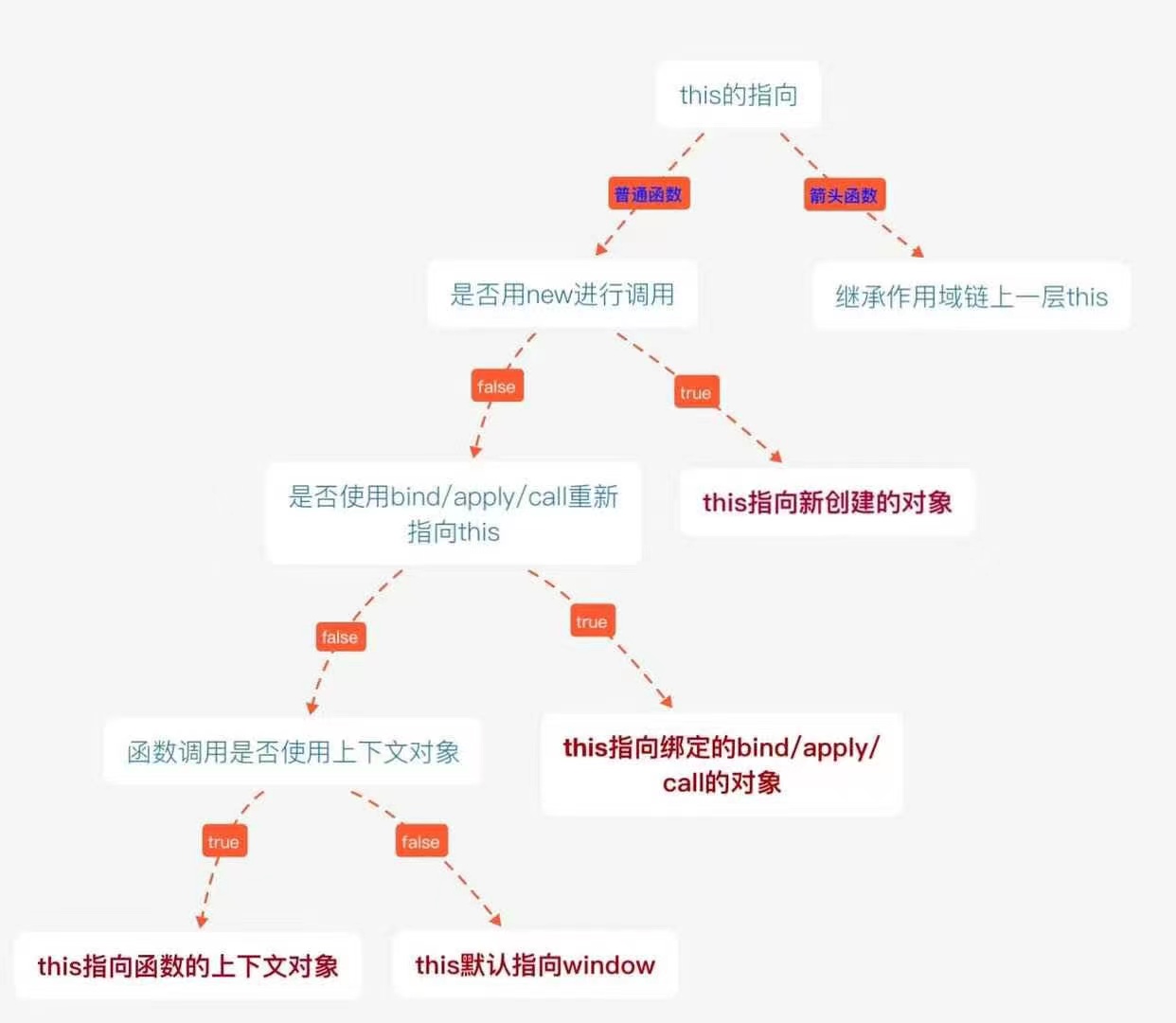【js 进阶】三分钟搞懂 JavaScript 中的 this 指向问题
前言
本文采用总分总的方式叙事:
总结
如果要判断一个运行中函数的 this 绑定,就需要找到这个函数的直接调用位置。找到之后就可以顺序应用下面这四条规则来判断 this 的绑定对象
由
new调用?绑定到新创建的对象由
call或者apply(或者bind)调用?绑定到指定的对象由上下文对象调用?绑定到那个
上下文对象默认:在严格模式下绑定到
undefined,否则绑定到全局对象ES6中的箭头函数,继承外层函数调用的this绑定
一图胜千言:

展开说明
下面将用伪代码验证总结的正确性
由 new 调用?绑定到新创建的对象
我们顺便回忆一下 new 操作做了什么?
- 创建(或者说构造)一个全新的对象
- 这个新对象会被执行
[[prototype]]连接 - 这个新对象会绑定到函数调用的
this - 如果函数没有返回其他对象,那么
new表达式中的函数调用会自动返回这个新对象
function Man(n, a) {
this.name = n
this.age = a
}
const xueyue = new Man('雪月', 18)
console.log(xueyue.name) // 雪月
console.log(xueyue.age) // 18由 call 或者 apply(或者 bind)调用?绑定到指定的对象
const { log } = console
const name = '雪月'
const age = 18
const obj = {
name: '安妮',
objAge: this.age,
fun: function (like, dislike) {
log(this.objAge)
log(this.name + '今年' + this.age + '岁', '喜欢' + like + '不喜欢' + dislike)
},
}
const a = { name: '飞虎队', age: 19 }
const b = { name: '夜玫瑰', age: 20 }
const c = { name: '复仇者', age: 21 }
obj.fun.call(a, '雷神', '黑龙') // undefined 飞虎队今年19岁 喜欢雷神不喜欢黑龙
obj.fun.apply(b, ['火麒麟', '无影']) // undefined 夜玫瑰今年20岁 喜欢火麒麟不喜欢无影
obj.fun.bind(c, '巴雷特', 'AWM')() // undefined 复仇者今年21岁 喜欢巴雷特不喜欢AWM由上下文对象调用?绑定到那个上下文对象
第三方库的许多函数,以及 JavaScript 语言和宿主环境中许多新的内置函数,都提供了一个可选的参数,通常被称为上下文(context),其作用和 bind(..) 一样, 确保你的回调函数使用指定的 this
function foo(el) {
console.log(el, this.id)
}
var obj = {
id: 'awesome',
}
// 调用 foo(..) 时把 this 绑定到 obj
;[1, 2, 3].forEach(foo, obj)
// 1 awesome
// 2 awesome
// 3 awesome默认:在严格模式下绑定到 undefined,否则绑定到全局对象
function foo() {
console.log(this.a)
}
a = 666
foo() // 666function foo() {
'use strict'
console.log(this.a)
}
a = 666
foo() // TypeError: Cannot read property 'a' of undefined特殊提示: 如果你把 null 或者 undefined 作为 this 的绑定对象传入 call、apply 或者 bind, 这些值在调用时会被忽略,实际应用的是默认绑定规则:
function foo() {
console.log(this.a)
}
var a = 2
foo.call(null) // 2那么什么情况下你会传入 null 呢?
一种非常常见的做法是使用 apply(..) 来 “展开” 一个数组,并当作参数传入一个函数。类似地,bind(..) 可以对参数进行柯里化(预先设置一些参数),这种方法有时非常有用
function foo(a, b) {
console.log('a:' + a + ', b:' + b)
}
// 把数组 展开 成参数
foo.apply(null, [2, 3]) // a:2, b:3
// 使用 bind(..) 进行柯里化
var bar = foo.bind(null, 2)
bar(3) // a:2, b:3然而,总是使用 null 来忽略 this 绑定可能产生一些副作用。如果某个函数确实使用了this(比如第三方库中的一个函数),那默认绑定规则会把 this 绑定到全局对象(在浏览 器中这个对象是 window),这将导致不可预计的后果(比如修改全局对象)。
显而易见,这种方式可能会导致许多难以分析和追踪的 bug
一种“更安全”的做法是传入一个特殊的对象(DMZ空对象),把 this 绑定到这个对象不会对你的程序产生任何副作用
function foo(a, b) {
console.log('a:' + a + ', b:' + b)
}
// 我们的 DMZ 空对象
var _dmz = Object.create(null)
// 把数组展开成参数
foo.apply(_dmz, [2, 3]) // a:2, b:3
// 使用 bind(..) 进行柯里化
var bar = foo.bind(_dmz, 2)
bar(3) // a:2, b:3ES6 中的箭头函数,继承外层函数调用的 this 绑定
function foo() {
setTimeout(() => {
// 这里的 this 在此法上继承自 foo()
console.log(this.a)
}, 100)
}
var obj = {
a: 18,
}
foo.call(obj) // 18等同于下面的 ES5
function foo() {
var self = this // lexical capture of this
setTimeout(function () {
console.log(self.a)
}, 100)
}
var obj = {
a: 18,
}
foo.call(obj) // 18结束
做道题检验一下
function Parent() {
this.a = 1
this.b = [1, 2, this.a]
this.c = { demo: 5 }
this.show = function () {
console.log(this.a, this.b, this.c.demo)
}
}
function Child() {
this.a = 2
this.change = function () {
this.b.push(this.a)
this.a = this.b.length
this.c.demo = this.a++
}
}
Child.prototype = new Parent()
var parent = new Parent()
var child1 = new Child()
var child2 = new Child()
child1.a = 11
child2.a = 12
parent.show() // 1 [1, 2, 1] 5
child1.show() // 11 [1, 2, 1] 5
child2.show() // 12 [1, 2, 1] 5
// 这涉及到原型链的知识
child1.change() // b = [1, 2, 1, 11] a = 5 demo = 4
child2.change() // b = [1, 2, 1, 11, 12] a = 6 demo = 5
parent.show() // 1 [1, 2, 1] 5
child1.show() // 5 [1, 2, 1, 11, 12] 5
child2.show() // 6 [1, 2, 1, 11, 12] 5